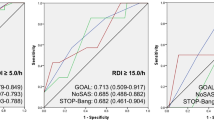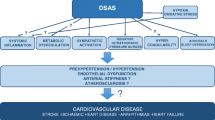Abstract
Purpose
Asthmatics have unique characteristics that may influence cardiovascular morbidity. We tested the association of lower airway caliber, obstructive sleep apnea (OSA), and other asthma-related factors, with systemic hypertension (HTN).
Methods
Asthma individuals at specialty clinics completed the Sleep Apnea scale of the Sleep Disorders Questionnaire (SA-SDQ). Medical records were reviewed for diagnosed HTN, OSA and comorbidities, spirometry, and current medications. FEV1% predicted was categorized as ≥80 (reference), 70–79, 60–69, and <60. SA-SDQ ≥36 for men and ≥32 for women defined high OSA risk.
Results
Among 812 asthmatics (mean age ± standard deviation: 46 ± 14 years), HTN was diagnosed in 191 (24 %), OSA in 65 (8 %), and OSA or high OSA risk (combined OSA variable) in 239 (29 %). HTN was more prevalent in lower FEV1% categories (p < 0.0001), in subjects with OSA, and those with combined OSA variable (55 vs. 21 % and 46 vs. 14 %, respectively, both p < 0.0001). With adjustment for covariates, associations with HTN remained significant for some FEV1% categories (70–79 % odds ratio = 1.60 [95 % CI 0.90–2.87]; 60–69 % 2.73 [1.28–5.79]; <60 % 0.96 [0.43–2.14]), and for OSA (2.20 [1.16–4.19]). The combined OSA variable in comparison with OSA alone demonstrated a stronger association with HTN (3.17 [1.99–5.04]) in a reiteration of this model. Inhaled corticosteroids (ICS) at lowest doses, in comparison to no ICS use had an independent “protective” association with HTN (0.44 [0.22–0.90]).
Conclusions
In this young population, worse lower airways obstruction and OSA were associated with HTN. In contrast, lower ICS doses attenuated likelihood for HTN. Adequate control of airway inflammation at appropriate ICS doses, and screening for OSA may reduce the burden of HTN in asthma.



Similar content being viewed by others
Abbreviations
- AHI:
-
Apnea–hypopnea index
- BMI:
-
Body mass index (in kilograms per meter squared)
- CI:
-
Confidence interval
- CPAP:
-
Continuous positive airway pressure
- COPD:
-
Chronic obstructive pulmonary disease
- CRP:
-
C-reactive protein
- FEF25–75 :
-
Forced expiratory flow between 25 and 75 % of vital capacity
- FEV1 :
-
Forced expiratory volume in first second of the vital capacity
- FVC:
-
Forced vital capacity
- GERD:
-
Gastroesophageal reflux disease
- HTN:
-
Systemic hypertension
- IH:
-
Intermittent hypoxia related to obstructive sleep apnea
- ICS:
-
Inhaled corticosteroid
- LABA:
-
Long acting β2-Agonist
- LTM:
-
Leukotriene modifiers
- NAEPP:
-
National asthma education and prevention program
- NHANES:
-
National health and nutrition examination survey
- OR:
-
Odds ratio
- OSA:
-
Obstructive sleep apnea
- PEFR:
-
Peak expiratory flow rate
- PSG:
-
Polysomnography (laboratory-based sleep study)
- SA-SDQ:
-
Sleep Apnea scale of the Sleep Disorders Questionnaire
- SD:
-
Standard deviation of the mean
References
American Thoracic Society, & Medical section of the American Lung Association (1987) Standards for the diagnosis and care of patients with chronic obstructive pulmonary disease (COPD) and asthma. Am Rev Respir Dis 136(1):225–244
Auckley D, Moallem M, Shaman Z et al (2008) Findings of a Berlin Questionnaire survey: comparison between patients seen in an asthma clinic versus internal medicine clinic. Sleep Med 9:494–499
Bettiol J, Bartsch P, Louis R et al (2000) Cytokine production from peripheral whole blood in atopic and nonatopic asthmatics: relationship with blood and sputum eosinophilia and serum IgE levels. Allergy 55:1134–1141
Bjermer L (2007) Time for a paradigm shift in asthma treatment: from relieving bronchospasm to controlling systemic inflammation. J Allergy Clin Immunol 120:1269–1275
Capra V, Back M, Barbieri SS et al (2012) Eicosanoids and their drugs in cardiovascular diseases: focus on atherosclerosis and stroke. Med Res Rev. doi:10.1002/med.21251
Center for Disease Control and Prevention: National Center for Health Statistics. US Department of Health and Human Services (2013) FastStats. Hypertension 2009–2010. http://www.cdc.gov/nchs/fastats/hyprtens.htm. Accessed 28 Apr 2013
Chae CU, Lee RT, Rifai N et al (2001) Blood pressure and inflammation in apparently healthy men. Hypertension 38:399–403
Chan CS, Woolcock AJ, Sullivan CE (1988) Nocturnal asthma: role of snoring and obstructive sleep apnea. Am Rev Respir Dis 137:1502–1504
Chobanian AV, Bakris GL, Black HR et al (2003) The seventh report of the Joint National Committee on Prevention, Detection, Evaluation, and Treatment of High Blood Pressure: the JNC 7 report. JAMA 289:2560–2572
Ciftci TU, Ciftci B, Guven SF et al (2005) Effect of nasal continuous positive airway pressure in uncontrolled nocturnal asthmatic patients with obstructive sleep apnea syndrome. Respir Med 99:529–534
Denburg JA, Sehmi R, Saito H et al (2000) Systemic aspects of allergic disease: bone marrow responses. J Allergy Clin Immunol 106:S242–S246
Dogra S, Ardern CI, Baker J (2007) The relationship between age of asthma onset and cardiovascular disease in Canadians. J Asthma 44:849–854
Douglass AB, Bornstein R, Nino-Murcia G et al (1994) The Sleep Disorders Questionnaire. I: creation and multivariate structure of SDQ. Sleep 17:160–167
Girdhar A, Kumar V, Singh A et al (2011) Systemic inflammation and its response to treatment in patients with asthma. Respir Care 56:800–805
Go AS, Hylek EM, Phillips KA et al (2001) Prevalence of diagnosed atrial fibrillation in adults: national implications for rhythm management and stroke prevention: the AnTicoagulation and Risk Factors in Atrial Fibrillation (ATRIA) Study. JAMA 285:2370–2375
Guilleminault C, Quera-Salva MA, Powell N et al (1988) Nocturnal asthma: snoring, small pharynx and nasal CPAP. Eur Respir J 1:902–907
Halasz A, Cserhati E, Kosa L et al (2003) Relationship between the tumor necrosis factor system and the serum interleukin-4, interleukin-5, interleukin-8, eosinophil cationic protein, and immunoglobulin E levels in the bronchial hyperreactivity of adults and their children. Allergy Asthma Proc 24:111–118
Huiart L, Ernst P, Ranouil X et al (2005) Low-dose inhaled corticosteroids and the risk of acute myocardial infarction in COPD. Eur Respir J 25:634–639
Jousilahti P, Salomaa V, Hakala K et al (2002) The association of sensitive systemic inflammation markers with bronchial asthma. Ann Allergy Asthma Immunol 89:381–385
Julien JY, Martin JG, Ernst P et al (2009) Prevalence of obstructive sleep apnea–hypopnea in severe versus moderate asthma. J Allergy Clin Immunol 124:371–376
Kapa S, Sert Kuniyoshi FH, Somers VK (2008) Sleep apnea and hypertension: interactions and implications for management. Hypertension 51:605–608
Libby P, Ridker PM, Hansson GK (2009) Inflammation in atherosclerosis: from pathophysiology to practice. J Am Coll Cardiol 54:2129–2138
Lopez-Jimenez F, Sert Kuniyoshi FH, Gami A (2008) Obstructive sleep apnea: implications for cardiac and vascular disease. Chest 133:793–804
Martin RJ, Szefler SJ, Chinchilli VM et al (2002) Systemic effect comparisons of six inhaled corticosteroid preparations. Am J Respir Crit Care Med 165:1377–1383
Nelson HS, Weiss ST, Bleecker ER et al (2006) The Salmeterol Multicenter Asthma Research Trial: a comparison of usual pharmacotherapy for asthma or usual pharmacotherapy plus salmeterol. Chest 129:15–26
Nieto FJ, Young TB, Lind BK et al (2000) Association of sleep-disordered breathing, sleep apnea, and hypertension in a large community-based study. Sleep Heart Health Study. JAMA 283:1829–1836
Pauletto P, Rattazzi M (2006) Inflammation and hypertension: the search for a link. Nephrol Dial Transplant 21:850–853
Poch E (2003) Role of lipoxygenase metabolites in cardiovascular disease. Curr Hypertens Rep 5:1–2
Qureshi AI, Suri MF, Kirmani JF et al (2005) Prevalence and trends of prehypertension and hypertension in United States: National Health and Nutrition Examination Surveys 1976 to 2000. Med Sci Monit 11:CR403–CR409
Rasmussen F, Mikkelsen D, Hancox RJ et al (2009) High-sensitive C-reactive protein is associated with reduced lung function in young adults. Eur Respir J 33:382–388
Ryan S, Taylor CT, Mcnicholas WT (2009) Systemic inflammation: a key factor in the pathogenesis of cardiovascular complications in obstructive sleep apnoea syndrome? Thorax 64:631–636
Sin DD, Wu L, Man SF (2005) The relationship between reduced lung function and cardiovascular mortality: a population-based study and a systematic review of the literature. Chest 127:1952–1959
Teodorescu M, Consens FB, Bria WF et al (2006) Correlates of daytime sleepiness in patients with asthma. Sleep Med 7:607–613
Teodorescu M, Peterson RG, Consens FB et al (2008) Predictors of systemic hypertension in patients with asthma. Am J Respir Crit Care Med 177:A90
Thorleifsson SJ, Margretardottir OB, Gudmundsson G et al (2009) Chronic airflow obstruction and markers of systemic inflammation: results from the BOLD study in Iceland. Respir Med 103:1548–1553
US Department of Health and Human Services. National Institute of Health; National Heart, Lung and Blood Institute (2013) National Asthma Education and Prevention Program. Expert Panel Report 3 (EPR-3): guidelines for the diagnosis and management of asthma. Full report 2007. http://www.nhlbi.nih.gov/guidelines/asthma/asthgdln.pdf. Accessed 15 Apr 2013
Van Der Hooft CS, Heeringa J, Brusselle GG et al (2006) Corticosteroids and the risk of atrial fibrillation. Arch Intern Med 166:1016–1020
Wei L, Macdonald TM, Walker BR (2004) Taking glucocorticoids by prescription is associated with subsequent cardiovascular disease. Ann Intern Med 141:764–770
Yokoyama A, Kohno N, Fujino S et al (1995) Circulating interleukin-6 levels in patients with bronchial asthma. Am J Respir Crit Care Med 151:1354–1358
Young T, Palta M, Dempsey J et al (1993) The occurrence of sleep-disordered breathing among middle-aged adults. N Engl J Med 328:1230–1235
Young T, Evans L, Finn L et al (1997) Estimation of the clinically diagnosed proportion of sleep apnea syndrome in middle-aged men and women. Sleep 20:705–706
Acknowledgments
The authors are grateful to the study subjects at both institutions, for their participation. As well, to student assistants for administering the questionnaires in clinics, and for data entry. We recognize the help from the providers and staff at the Pulmonary Clinics and Briarwood Asthma-Airways Center at the University of Michigan-Ann Arbor, and Allergy and Pulmonary Clinics at the University of Wisconsin-Madison in recruiting subjects for this study. This study was funded by the University of Michigan General Clinical Research Center (MO1 RR00042) and Neurology Department Training Grant 5T32NS007222; University of Wisconsin School of Medicine and Public Health, Department of Medicine, and Medical Education and Research Committee - New Investigator Award; 1UL1RR025011 from the Clinical and Translational Science Award (CTSA) program of the National Center for Research Resources, National Institutes of Health; and additional resources from William S. Middleton Memorial VA Hospital, Madison, Wisconsin.
Conflict of interest
Drs. S Ferguson, RE Gangnon, FB Consens, MC Teodorescu, and Ms. AG Peterson have no relationships to disclose. Dr. Mihaela Teodorescu received funding from the University of Wisconsin School of Medicine and Public Health, Department of Medicine and Medical Education and Research Committee-New Investigator Award, and National Institutes of Health, National Center for Research Resources (MO1 RR00042 and 1UL1RR025011 Clinical and Translational Science Award [CTSA] program), for asthma-sleep apnea research. Dr. RD Chervin has received research support from the National Institutes of Health and Fox Foundation; has served on advisory boards for Pavad Medical, not-for-profit Sweet Dreamzzz, and the NHLBI (Sleep Disorders Research Advisory Board); is a section editor for UpToDate, Inc.; received support for educational purposes from Philips Respironics, Inc. and Fisher Paykel, Inc.; has consulted for Arena Pharmaceuticals, Proctor & Gamble, and Zansors; serves on boards of directors for the American Academy of Sleep Medicine and the International Pediatric Sleep Association; and is named in University of Michigan patents for algorithms and devices to facilitate diagnosis and treatment of sleep disorders. The content of this article is solely the responsibility of the authors and does not represent the views of the US Department of Veterans Affairs, NIH or the United States Government.
Author information
Authors and Affiliations
Corresponding author
Rights and permissions
About this article
Cite this article
Ferguson, S., Teodorescu, M.C., Gangnon, R.E. et al. Factors Associated with Systemic Hypertension in Asthma. Lung 192, 675–683 (2014). https://doi.org/10.1007/s00408-014-9600-y
Received:
Accepted:
Published:
Issue Date:
DOI: https://doi.org/10.1007/s00408-014-9600-y




